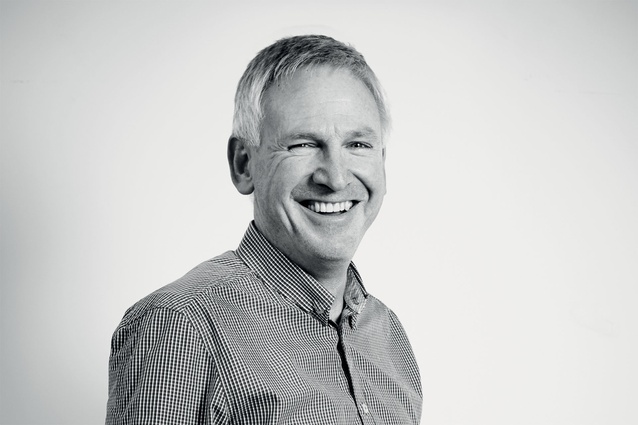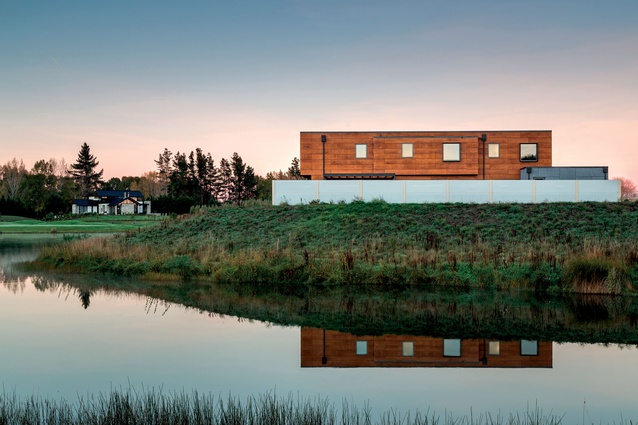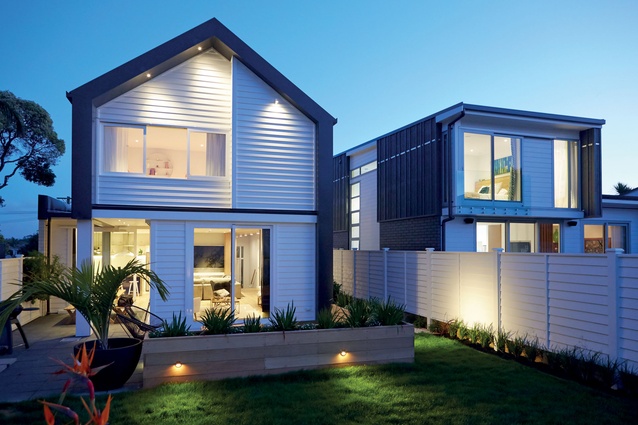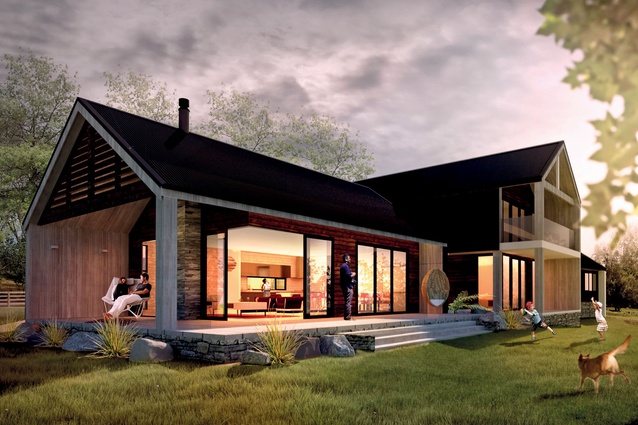Q & A: Alisdair Daines of Context Architects
Houses talks to architect Alisdair Daines of Context Architects about the rebuild and affordability.
Houses: Did you always want to be an architect?
Alisdair Daines: Probably from about the age of 12 was when I first started getting interested in it. I remember very vividly, at school, we were building a large, detailed model of a house, with all the proper framing and joists and flooring, the whole thing. It was an ongoing project that a few of us were involved in and that’s what started my interest. My father was involved in the building industry as was my grandfather, so I had had a little bit of exposure to what the industry was, but I vividly remember working on that model as the first thing that really got my interest going.
Houses: So by the time you got to high school you were decided?
AD: By the time I got to high school it was a strong interest and I researched more about it, and probably by the time I was about 15 I’d pretty much made up my mind that that’s what I wanted to carry on through university to study and get involved in.
Houses: And where did you grow up?
AD: I grew up in Blenheim, small town New Zealand. Ended up working in Wellington for a number of years and then my wife and I spent 25 years in Nelson. I ran my own business there for a large part of that time.
Houses: And interests outside of architecture?
AD: I’ve been heavily involved in sailing for a number of years. I’ve sailed boats of Flying Dutchman class up to world championship level, four world champs now and am also a qualified judge at national level. Sailing is something I thoroughly enjoy. It’s physically different and mentally demanding as well.
Houses: How did you come to be associated with Context Architects?
AD: I had worked with them on one of their jobs in Nelson and then a couple of years ago, the kids had gone off to university, and my wife said: “they’ve left home, we can leave too, what do you want to do for the next 10 years?” The opportunity came up with Context in Christchurch, so we said yeah let’s go for it.
Houses: How is Christchurch?
AD: Christchurch is interesting. It’s incredibly exciting and stimulating and frustrating all at the same time.
Houses: What frustrates you about it?
AD: Probably the lack of progress and the extra layers of bureaucracy. The exciting parts of it are the open nature of the work, the potential and the chance to be involved in the recreation of the whole city. At least it’s a lot better than it was. We’re now seeing some buildings being constructed and structures coming out of the ground, whereas 12 to 18 months ago it was still in demolition phase. Everything was happening below ground, it wasn’t apparent that anything was going on and I think at that point there was a feeling of frustration within the population that nothing was happening.
Houses: So, in your estimation, assuming that the amount of work needing to be undertaken is 100 percent of the work that needs to be done, where are we currently?
AD: Somewhere between the 20-30 percent mark.
Houses: So there’s still a long way to go.
AD: There is and it will be over a long period of time because there are lots of potential projects that aren’t even being talked about or thought about now. You’re not going to get the small retailers, the extra restaurants, bars and that happening in the middle of town until some office buildings are constructed that provide the population to make those small businesses viable. All cities grow organically over an extended period of time. You can’t just force that all to happen within a two- or three-year period. I expect that in 15 to 20 years’ time there will be buildings being developed on sites that are the hangover from the earthquake.
Houses: So do you think that’s part of the wider-scale frustration; people thinking it’s all there, the land’s there, the infrastructure is in place, why aren’t they building?
AD: Yes, and that’s where there hasn’t been enough information going out. Certainly, it’s not a politically expedient thing to come out and say: “hey, the rebuild is going to take 20 years”; It’s not what the population wants to hear, but it’s the reality. Don’t get me wrong, in another five to eight years it will feel like most things have been rebuilt and feel like there’s a city there once again, but the process will continue to be an ongoing one.
Houses: I was in Christchurch recently and one of the conversations being had was the new stadium (bounded by Hereford, Tuam, Barbados and Madras Streets) and its contribution to the live/work/play lifestyle of the rebuilt CBD. Is that your take on it as well?
AD: Oh absolutely. Christchurch has got an advantage in that it’s a much smaller city and is easily navigable on foot. Being close enough to where the action is, is a very attractive proposition to a lot of people; that they’re within walking distance to work, sporting amenities and nightlife, you don’t generally find that within any central city district and that’s what Christchurch will have going for it.
Houses: If you could design any particular type of building – residential, commercial, civic – as your own personal addition to Christchurch, what would you choose?
AD: A mixed-use type construction. Something reminiscent of the old suburban shop with the flat above, but on a larger more thought out scale. Doing that in a good quality environment in and around the edges of the city is the sort of work that I see as quite exciting and with the potential to have quite a reasonable influence and impact on the future work/life/culture in Christchurch.
Houses: Another hot media topic at the moment is ‘affordable housing’, which, to me, seems to be anything but…
AD: The affordable debate is an interesting one, politicians in particular love the topic, and yet I haven’t heard anybody give a clearly definable answer as to what constitutes affordable. I’ve seen formulas that state it should be a certain number of times gross income, as if one size fits all, yet that doesn’t necessarily equate to what is needed and what is appropriate. There’s been this shift in perception that houses have to be bigger, that in terms of space it’s about quantity rather than quality, which has a direct effect on cost, which in turn affects affordability.
Houses: That ties into something I hear all the time: ‘think resale value’. There’s this idea that a house needs to have four bedrooms, three bathrooms and so on. So right from the outset you’re building or buying a house not for yourself, but ultimately for somebody else to live in.
AD: That’s a very, very good summary of it, because if you’re designing a building for resale you’ll be creating what I call a ‘me too’ house and when you put it on the market the price you’ll get will be dictated by what the similar house next door or just down the road sells for. Also, if somebody doesn’t like it because they don’t like the colour of the front door, there’s a similar one down the road they can buy. Whereas with a bespoke, architecturally designed house, you’ll find that people become emotionally attached to it and want to buy it for that reason, which means the price is not quite so relevant. Now the ‘me too’ house you might get ten people come through and of those, you might have eight that say: ‘oh, this is nice, I’ll buy it if the price is right’. With the other, you might get ten people through but only two will experience that connection, but they’ll be saying: ‘hey, this is me, I’m going to have this and I’m going to fight that person to get it.’
Houses: One of the arguments I hear a lot is that it costs so much to get materials here. How bad is the building industry in New Zealand in terms of costs?
AD: It is a more expensive place to build compared to a lot of other countries. The construction industry has been very slow on the uptake of new materials and systems, some of that with justification. There have been various materials brought in and tried or used inappropriately, particularly through the 90s and early 2000s that resulted in the leaky home crisis. They were, most probably, inappropriate materials poorly used but as a consequence the construction industry is very, very conservative and if you look at the way we were building houses in the 1920s and 30s, essentially we’re using the same systems and techniques and materials now. If, as a comparison, you looked at car design and construction from the 20s and 30s and compare it to now, things have gone through probably nine or ten generations of developments, whereas you could say, construction-wise, we might only have progressed to the next generation over that same period of time. Basically, we have failed to import those same technological advances achieved in other industries into the construction industry, particularly in terms of factory production of components. We still, and this includes the mass housing companies, tend to do one off houses all the time. You could argue that we’ve seen some improvement what with factory-made frames and trusses compared to doing it on site 50 years ago but that’s a very subtle shift in construction techniques and methodology.
Houses: And why is that? Does it come down to public perception as well?
AD: I think it’s partly public driven – everybody wants their home to be a little bit different or personalised to suit them. Again, using cars as an analogy we’re quite happy to go down to the local car dealer and say: ‘That’s the model I want’ and we accept that, that’s fine. You don’t expect to go and have a custom car made, if you did, rather than a $50,000 car you know that it’s going to be a $400,000 or $500,000 vehicle. Yet, we all expect our houses to be custom made or a little bit different but we want the price to be down at that mass-produced level. Of course, that being said, topography, too, plays a role. In New Zealand we do a lot of construction on sloping sites, which precludes, for the most part, a standardised response, but there is definite room for improvement in terms of embracing technologies.
Houses: With technology making a more mass-produced product an inevitability, do you think there’s a potential there for an architecturally designed ‘mass product’?

AD: I think there is. There’s no excuse for having poor design in housing and yet we see it all the time, inappropriate siting, inefficient layouts, poor orientation for sun and ventilation, all of those sorts of things. Prefabrication does not mean lower quality design. It may result in less variation but it can mean that you create a higher standard average than exists at the moment. There will always be a market for that bespoke, high-end house but if mass production ups the standard of the average that’s being produced, that can only benefit the industry.
Houses: Moving away from ‘hot topics’ and getting back to a personal note, you mentioned at the start that you caught the architecture bug at 12 and by 15 your fate was pretty much sealed. What is it that makes you passionate for architecture?
AD: For me it has always been about creating buildings and structures that influence people’s lives, whether that be simply in providing the basic needs of warmth and shelter through to creating spaces that take people to a whole other level of experience.
Houses: Are there any buildings in New Zealand that you wish you had designed?
AD: That’s a tough one. There are a large number of buildings that I admire for various reasons but inevitably – and I think every architect would say this – while I may have loved to have been involved, I can’t help but think that I would have done it slightly differently. So purely for that reason, no, there’s nothing that springs to mind where I’d say: ‘That’s the perfect building, I would have loved to have designed that’. I’ve been to plenty though, from houses to commercial projects, which I think are just absolutely outstanding. In Christchurch terms the new one is the Botanic Gardens Pavilion that Pattersons was involved with. I think that’s really quite stunning. It’s a great building for where it is and what it’s being used for.
Houses: What about globally? Are you an architectural traveller?
AD: My wife and I have done a reasonable amount of travel. One of the aspects I find enjoyable is visiting buildings with my wife when I haven’t told her anything about them before going there and getting to see her reaction as a layperson. One of the best times was about 20-odd years ago on a trip to France, we were travelling around and I said: ‘There’s this little church I’d like to go and see’ – which was actually Le Corbusier’s chapel at Ronchamp – so we went along and my wife wandered around and had a look and said this just feels amazing. She said, ‘I can’t put my finger on it but it’s so different to what I expected, inside it just feels so peaceful and serene and you go outside and it’s stunning’. But equally, there’s what I’d call non-architectural buildings. Just little gems, the small things you find in different places that are really quite delightful and some of the things that have just happened rather than necessarily having been designed and created, such as how two buildings may just relate to each other in a courtyard or a laneway space. A few years ago, in a Melbourne laneway, we came upon a small impromptu music concert and the space almost acted like a mini amphitheatre. It was great how the people were shaping the buildings and spaces around them to a different purpose.
Houses: Do you think that that should be a central tenet within architecture?
AD: Yes, I think we should definitely be creating spaces and buildings that are flexible, that have the ability to be used in a number of ways. To me part of the success lies in how the owners, the occupiers and the general public interact with a space, it’s fantastic to see, particularly in something that’s got a public context to it because a building as an object is a little bit pointless without people actually using it.
Houses: So, if you were to design a house for yourself, and let us say that it has to be in New Zealand, where would you choose to put it?
AD: My favourite place in the country is the Marlborough Sounds. We have a property there that we’ve considered various options for, but that’s where I’d put it – not necessarily on the piece that we own but definitely there. It would have to be a house that was very flexible, one that could operate on several levels, almost formal living, but also as the relaxed holiday-type property and just nestled into the environment so that it almost disappears. That’s where the environment and landscape is much, much stronger than any building and I wouldn’t want to try and put my mark on the landscape, I’d want to put it in the landscape.















